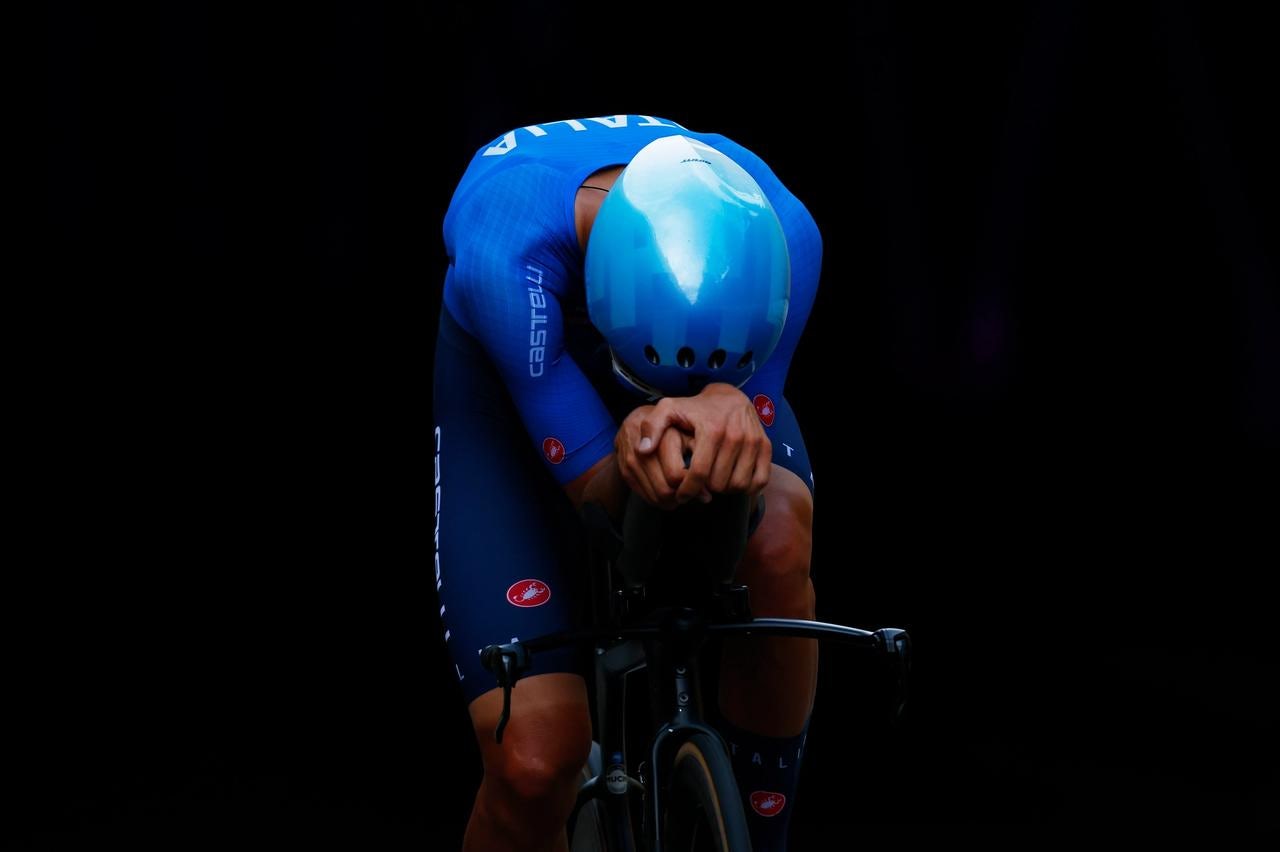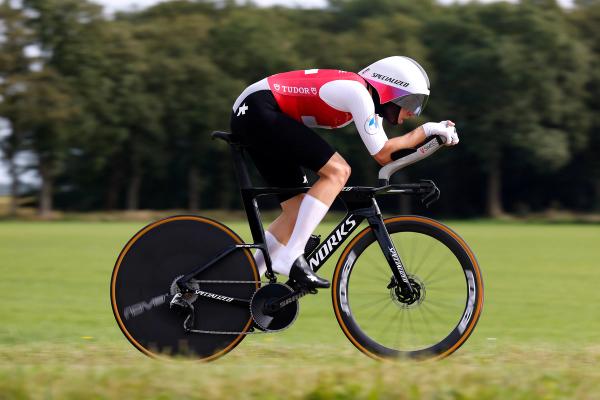Head-down TT position: Dangers back in the spotlight, despite new UCI rules
Stefan Küng’s crash at the European Championships raises important safety questions over the oft-used time trial position
Patrick Fletcher
Deputy Editor
© Sprint Cycling Agency
Many riders adopt the head-down TT position, but is it safe?
Stefan Küng crossed the finish line of the European Championships time trial with his helmet caved in and blood spattered across his skinsuit like he’d wandered into a Tarantino movie. The incident, though, was not just shocking for its aftermath, but also for how it came about.
The Swiss rider, one of the best time triallists in the world and in medal contention on Wednesday, rode straight into a set of barriers in the closing kilometres of the course. Apparently, he was completely unaware of their presence, and only seemed to clock them at the moment it was too late. His front wheel made contact and he was flung head-first into the barrier.

© Sprint Cycling Agency
Stefan Küng arrived at the line with a broken helmet and covered in blood
The incident generated a great deal of media attention, with the sight of Küng at the line genuinely disturbing, not least because of the question of whether he should have been allowed back on his bike at all. But there was also debate over how Küng got himself into that situation in the first place.
“The crazy trend for head down riding in time trials strikes again,” wrote the former UCI and British Cycling president Brian Cookson on social media.
Indeed, this is a familiar issue, not only on the pro circuit but also, and more pressingly, on the amateur time trial scene. Head-down riding is practised all over the world, and while it may bring aerodynamic advantages, it also carries significant dangers.
"The UCI really must look at the technical rules to stop this,” Cookson added. In fact, they already have, but more on that later.
The risks and rewards of the head-down position
The head-down position is essentially where a rider lowers their head so that their eyes are pointed down at the road directly beneath them, rather than out at what’s in front.
It is done for its aerodynamic benefits, with the basic premise that a head that’s tucked down catches less of the wind and causes less drag. When using time trial extension bars, the science says that it’s better to have your head and hands closer together, rather than having a big gap between them. One larger frontal area punching one hole in the wind is more efficient than two separate smaller areas punching separate holes.
GCN recently put this to the test, measuring Alex Paton in both positions on the Llandow Circuit in Wales. Keeping the variables the same, Alex put out the exact same power - 271 watts - for both rides, covering three laps of the circuit in 7:03 for the head-up position, and 6:49 for the head-down position - a saving of 14 seconds over 4.3km.
However, that comes at a cost.
"With my head down, my front visibility is incredibly poor," he said. "What I’m using as my reference point is the white line at the side of the track. Because we’re in the controlled safe environment of a race track, I know I can do that, but if was out on the road that would be a big no-no.”
This position has been linked to a number of crashes. Küng was evidently not aware of what was in front of him, while another stand-out moment was the Danish pursuit team riding into the back of a British rider on the track at the Tokyo Olympics.
Chris Froome, the four-time Tour de France champion whose career has never been the same since a crash on a TT bike in 2019, has called for a ban on TT bikes in professional cycling, while the rider who succeeded him as Tour champion, Egan Bernal, nearly died last year when he crashed into the back of a lorry on his TT bike.
Where does the UCI rule come in?
At the start of 2023, the UCI changed its rules surrounding time trial extensions, and by extension rider positions. This was partly designed to combat the head-down issue.
As well as a limit on the angle of TT extensions, there used to be a limit on their height, which was 100mm vertically from the middle of the arm-rest pad to the very top tip of the bars. Crucially, this applied to riders of all shapes and sizes. What that meant was that smaller riders, such as Remco Evenepoel, would be able to have their hands, relatively speaking, higher up and closer to the face. Taller riders, such as Filippo Ganna, would be left with more of a gap, and some would look to close that by lowering their head.

© Velo Collection (TDW) / Getty Images
World Champion Remco Evenepoel has one of the most aerodynamic TT positions
There were also other little hacks, such as only gripping the ends of the extensions with the pinky fingers, but once again this carries significant safety risks.
“At the moment, because of this UCI rule, we are having to bring our head to our hands, and then to try and look up becomes massively difficult,” four-time British TT champion Alex Dowsett said last year, ahead of the rule change.
"If that rule were to be relaxed and we were allowed to bring our hands actually up to our heads, I think that could help with so much of the head-down riding we’re commonly seeing, and improve safety."
Dowsett’s calls were indeed answered. This year, the UCI has brought in new regulations that split the TT extension height rule according to a rider’s height. Riders are divided into three categories of height, with each carrying a different limit for the vertical difference between the extension tip and mid-point of the arm support.
- Up to 180cm - 100mm
- 180cm and above - 120mm
- 190cm and above - 140mm
Küng, who measures 193cm, was someone who benefited from this change, with a 40% shift in the distance between hands and face.
The move was deemed a step towards a level playing field in a sporting sense, but this latest episode would suggest it has not eliminated the safety risks of head position on time trial bikes.
What about amateurs?
The important thing about the UCI rules is that they only apply, well, to UCI-classified races. In amateur time trialling events, riders have always had much more freedom to play around with their equipment and positions.
It may be surprising, then, that the head-down debate is such a pressing one, at least on the UK time trialling scene. The obstacle the pros were looking to get around doesn’t exist for most riders.
That can probably be explained by access to equipment and to information surrounding aerodynamics. Many recreational racers won’t look to invest in TT extensions, so will take the ones that come on their TT bike - if of course they even have a TT bike - and adapt their bodies for what they feel is the most aerodynamic position.
It’s also worth pointing out that most amateurs are not only less able to afford this equipment, but can't test it out as scientifically as the pros, who have access to wind tunnels filled with expert analysts. With no expert input, many riders will default to the position they see pro riders using, which has often been the head-down option.
On every level of riding, the debate doesn’t seem to have gone away, but should it even be a debate?
“I think in almost any situation, safety needs to come above the importance of aerodynamics,” says Alex Paton.
What do you think of the head-down time trial position? Let us know in the comments. For more tech news, head over to the Tech section on the GCN website, linked here.


TT-ME.jpg?w=600&auto=format)









